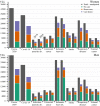Years of life lost during the Covid-19 pandemic in Sweden considering variation in life expectancy by level of geriatric care
- PMID: 36127511
- PMCID: PMC9488891
- DOI: 10.1007/s10654-022-00915-z
Years of life lost during the Covid-19 pandemic in Sweden considering variation in life expectancy by level of geriatric care
Abstract
The Covid-19 pandemic has not affected the population evenly. This must be acknowledged when it comes to understanding the Covid-19 death toll and answering the question of how many life years have been lost. We use level of geriatric care to account for variation in remaining life expectancy among individuals that died during 2020. Based on a linkage of administrative registers, we estimate remaining life expectancy stratified by age, sex, and care status using an incidence-based multistate model and analyze the number of years of life lost (YLL) during 2020 in Sweden. Our results show that remaining life expectancy between individuals with and without care differs substantially. More than half of all Covid-19 deaths had a remaining life expectancy lower than 4 years. Yet, in a 1-year perspective, Covid-19 did not seem to replace other causes of death. Not considering the differences in remaining life expectancy in the affected populations overestimated YLL by 40% for women and 30% for men, or around 2 years per death. While the unadjusted YLL from Covid-19 amounted to an average of 7.5 years for women and 8.6 years for men, the corresponding YLL adjusted for care status were 5.4 and 6.6, respectively. The total number of YLL to Covid-19 in 2020 is comparable to YLL from ischemic heart disease in 2019 and 2020. Our results urge the use of subgroup specific mortality when counting the burden of Covid-19. YLL are considerably reduced when the varying susceptibility for death is considered, but even if most lifespans were cut in the last years of life, the YLL are still substantial.
Keywords: Care home; Covid-19; Excess deaths; Life expectancy; Multistate model; Years of life lost.
© 2022. The Author(s).
Conflict of interest statement
The authors have no relevant financial or non-financial interests to disclose.
Figures




Similar articles
-
Quantifying income inequality in years of life lost to COVID-19: a prediction model approach using Dutch administrative data.Int J Epidemiol. 2024 Feb 1;53(1):dyad159. doi: 10.1093/ije/dyad159. Int J Epidemiol. 2024. PMID: 38081182 Free PMC article.
-
Comparison of years of life lost to 1,565 suicides versus 10,650 COVID-19 deaths in 2020 in Sweden: four times more years of life lost per suicide than per COVID-19 death.Ups J Med Sci. 2022 May 11;127. doi: 10.48101/ujms.v127.8533. eCollection 2022. Ups J Med Sci. 2022. PMID: 35722184 Free PMC article.
-
Evaluation of the effect of the COVID-19 pandemic on the all-cause, cause-specific mortality, YLL, and life expectancy in the first 2 years in an Iranian population-an ecological study.Front Public Health. 2023 Oct 19;11:1259202. doi: 10.3389/fpubh.2023.1259202. eCollection 2023. Front Public Health. 2023. PMID: 37927873 Free PMC article.
-
Estimates of years of life lost depended on the method used: tutorial and comparative investigation.J Clin Epidemiol. 2022 Oct;150:42-50. doi: 10.1016/j.jclinepi.2022.06.012. Epub 2022 Jun 24. J Clin Epidemiol. 2022. PMID: 35760239 Review.
-
The burden of premature mortality from cardiovascular diseases: A systematic review of years of life lost.PLoS One. 2023 Apr 21;18(4):e0283879. doi: 10.1371/journal.pone.0283879. eCollection 2023. PLoS One. 2023. PMID: 37083866 Free PMC article.
Cited by
-
Cause-specific excess mortality in Denmark, Finland, Norway, and Sweden during the COVID-19 pandemic 2020-2022: a study using nationwide population data.Eur J Epidemiol. 2024 Sep;39(9):1037-1050. doi: 10.1007/s10654-024-01154-0. Epub 2024 Sep 16. Eur J Epidemiol. 2024. PMID: 39285102 Free PMC article.
-
How should we speak about years of life lost (YLL) values?Eur J Epidemiol. 2023 Mar;38(3):345-347. doi: 10.1007/s10654-023-00966-w. Epub 2023 Mar 6. Eur J Epidemiol. 2023. PMID: 36877277 Free PMC article. No abstract available.
-
Waves of inequality: income differences in intensive care due to Covid-19 in Sweden.Eur J Public Health. 2023 Aug 1;33(4):574-579. doi: 10.1093/eurpub/ckad094. Eur J Public Health. 2023. PMID: 37322545 Free PMC article.
-
Direct and indirect impacts of the COVID-19 pandemic on life expectancy and person-years of life lost with and without disability: A systematic analysis for 18 European countries, 2020-2022.PLoS Med. 2025 Mar 11;22(3):e1004541. doi: 10.1371/journal.pmed.1004541. eCollection 2025 Mar. PLoS Med. 2025. PMID: 40067869 Free PMC article.
-
The contribution of population age-sex structure to the excess mortality estimates of 2020-2021 in Denmark, Finland, Iceland, Norway, and Sweden.SSM Popul Health. 2023 Jun;22:101377. doi: 10.1016/j.ssmph.2023.101377. Epub 2023 Mar 5. SSM Popul Health. 2023. PMID: 36919136 Free PMC article.
References
MeSH terms
Grants and funding
LinkOut - more resources
Full Text Sources
Medical

